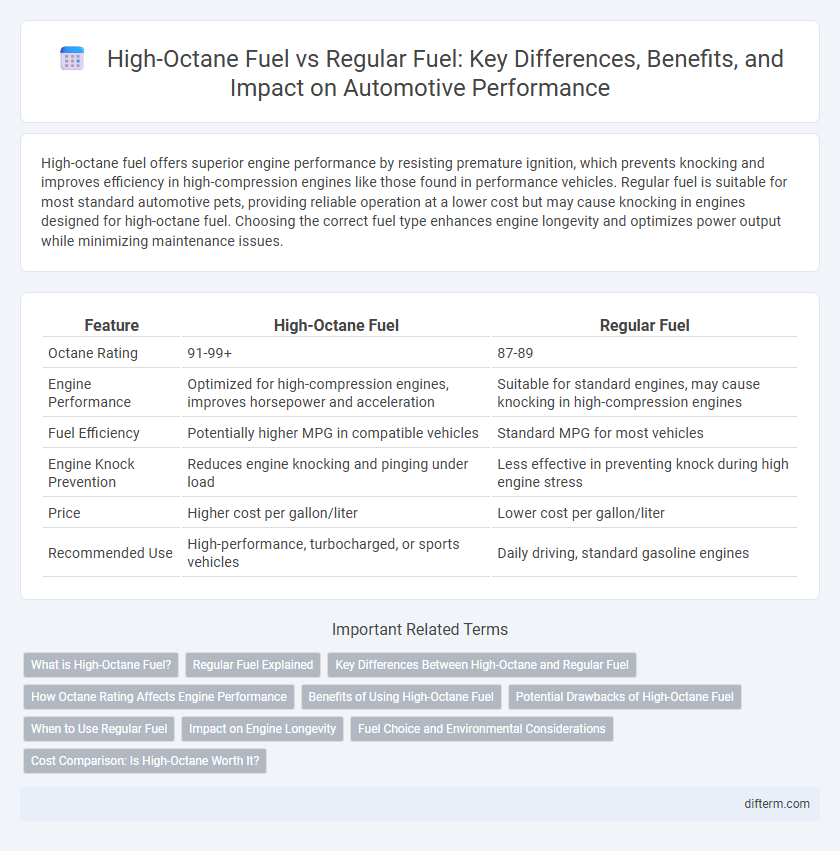High-octane fuel offers superior engine performance by resisting premature ignition, which prevents knocking and improves efficiency in high-compression engines like those found in performance vehicles. Regular fuel is suitable for most standard automotive pets, providing reliable operation at a lower cost but may cause knocking in engines designed for high-octane fuel. Choosing the correct fuel type enhances engine longevity and optimizes power output while minimizing maintenance issues.
Table of Comparison
| Feature | High-Octane Fuel | Regular Fuel |
|---|---|---|
| Octane Rating | 91-99+ | 87-89 |
| Engine Performance | Optimized for high-compression engines, improves horsepower and acceleration | Suitable for standard engines, may cause knocking in high-compression engines |
| Fuel Efficiency | Potentially higher MPG in compatible vehicles | Standard MPG for most vehicles |
| Engine Knock Prevention | Reduces engine knocking and pinging under load | Less effective in preventing knock during high engine stress |
| Price | Higher cost per gallon/liter | Lower cost per gallon/liter |
| Recommended Use | High-performance, turbocharged, or sports vehicles | Daily driving, standard gasoline engines |
What is High-Octane Fuel?
High-octane fuel contains a higher octane rating, typically 91 or above, which allows engines to withstand greater compression without knocking or pinging. It enhances performance in high-compression or turbocharged engines by preventing premature ignition and improving combustion efficiency. Using high-octane fuel in compatible vehicles can lead to smoother operation and potentially increased horsepower compared to regular fuel with an octane rating of 87.
Regular Fuel Explained
Regular fuel, typically rated at 87 octane, is designed for most vehicles with standard engines and offers sufficient combustion stability for everyday driving conditions. Using regular fuel maximizes cost-efficiency without compromising engine performance in vehicles not requiring higher octane. It contains additives that help prevent engine knocking and maintain cleanliness, ensuring optimal operation in standard internal combustion engines.
Key Differences Between High-Octane and Regular Fuel
High-octane fuel typically has an octane rating of 91 or higher, designed to prevent engine knocking in high-performance or turbocharged engines, while regular fuel usually ranges from 87 to 89 octane suitable for standard combustion engines. High-octane fuel delivers more efficient combustion and better performance under high compression, whereas regular fuel is optimized for everyday driving and offers lower cost. Choosing the correct fuel based on engine requirements impacts engine longevity, fuel efficiency, and power output significantly.
How Octane Rating Affects Engine Performance
Higher octane fuel resists knocking and allows engines to operate at higher compression ratios, enhancing power output and efficiency. High-octane fuel is essential for performance and turbocharged engines designed to maximize combustion without premature detonation. Using regular fuel in engines requiring high-octane can lead to reduced performance, increased engine knock, and potential long-term damage.
Benefits of Using High-Octane Fuel
High-octane fuel offers superior engine performance by preventing knocking and ensuring smoother combustion in high-compression engines. It enhances fuel efficiency and prolongs engine life by reducing carbon deposits and minimizing wear. Drivers of performance vehicles benefit from increased power output and improved acceleration when using high-octane fuel.
Potential Drawbacks of High-Octane Fuel
High-octane fuel offers enhanced engine performance but can lead to increased fuel costs and reduced fuel economy in vehicles not designed for it. Using high-octane fuel in engines calibrated for regular fuel may cause incomplete combustion, resulting in carbon buildup and potential engine deposits. Moreover, reliance on premium fuel without proper engine requirements provides minimal performance benefits, making it an inefficient choice for most standard vehicles.
When to Use Regular Fuel
Regular fuel, typically with an octane rating of 87, is best suited for vehicles with engines designed for standard compression ratios, ensuring optimal performance without engine knocking. Using regular fuel in cars engineered for high-octane fuel can lead to decreased fuel efficiency and potential long-term engine damage, while most everyday commuter vehicles operate efficiently on regular fuel. Selecting regular fuel reduces fuel costs and maintains engine health when high-octane fuel is not explicitly required by the manufacturer.
Impact on Engine Longevity
High-octane fuel reduces engine knocking by resisting premature combustion, which helps maintain optimal engine timing and performance. Using high-octane fuel in engines designed for regular fuel typically offers no longevity benefits, as these engines do not experience knocking under normal conditions. Prolonged use of the appropriate fuel grade contributes to preserving engine components and preventing wear caused by detonation or inefficient combustion.
Fuel Choice and Environmental Considerations
High-octane fuel improves engine performance and efficiency by preventing knocking in high-compression engines, leading to optimized combustion and reduced emissions. Regular fuel, while less expensive, may result in incomplete combustion and higher pollutant output in vehicles designed for premium fuel. Choosing the appropriate fuel based on engine requirements can minimize environmental impact and enhance fuel economy.
Cost Comparison: Is High-Octane Worth It?
High-octane fuel typically costs 20-40% more than regular fuel, with prices varying based on location and brand, impacting overall fuel expenses significantly. Vehicles engineered for high compression engines or turbochargers benefit from improved performance and efficiency when using premium fuel, potentially offsetting the higher cost through better mileage and reduced engine knocking. For standard engines, the performance gains are minimal, making regular fuel the more cost-effective option in everyday driving scenarios.
high-octane fuel vs regular fuel Infographic

 difterm.com
difterm.com